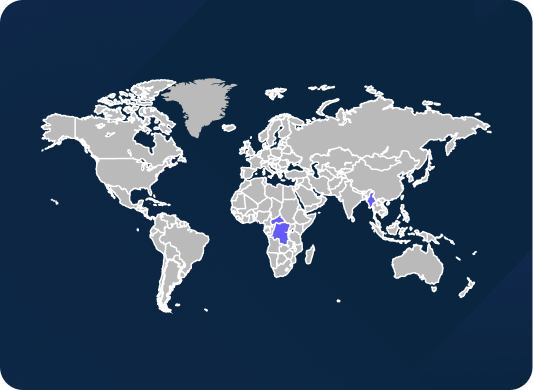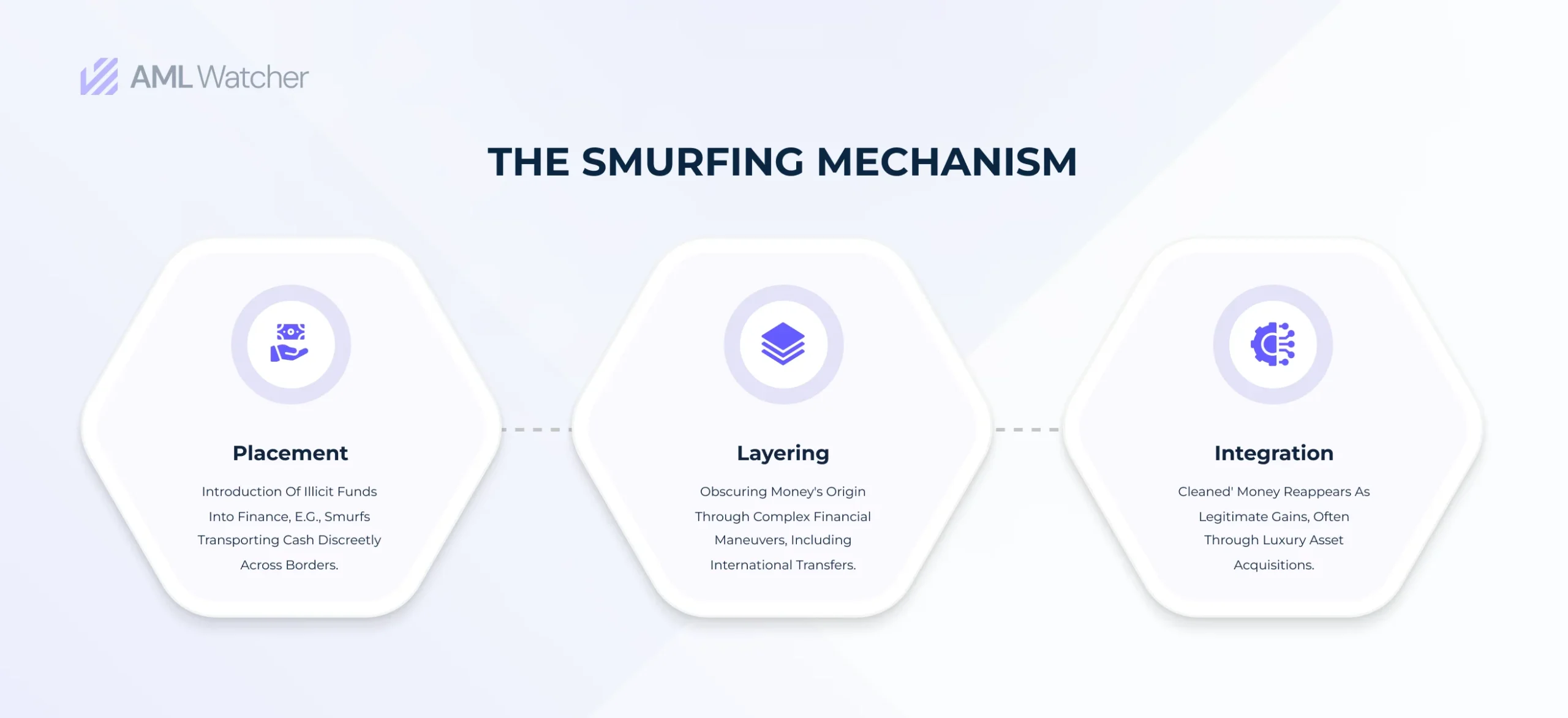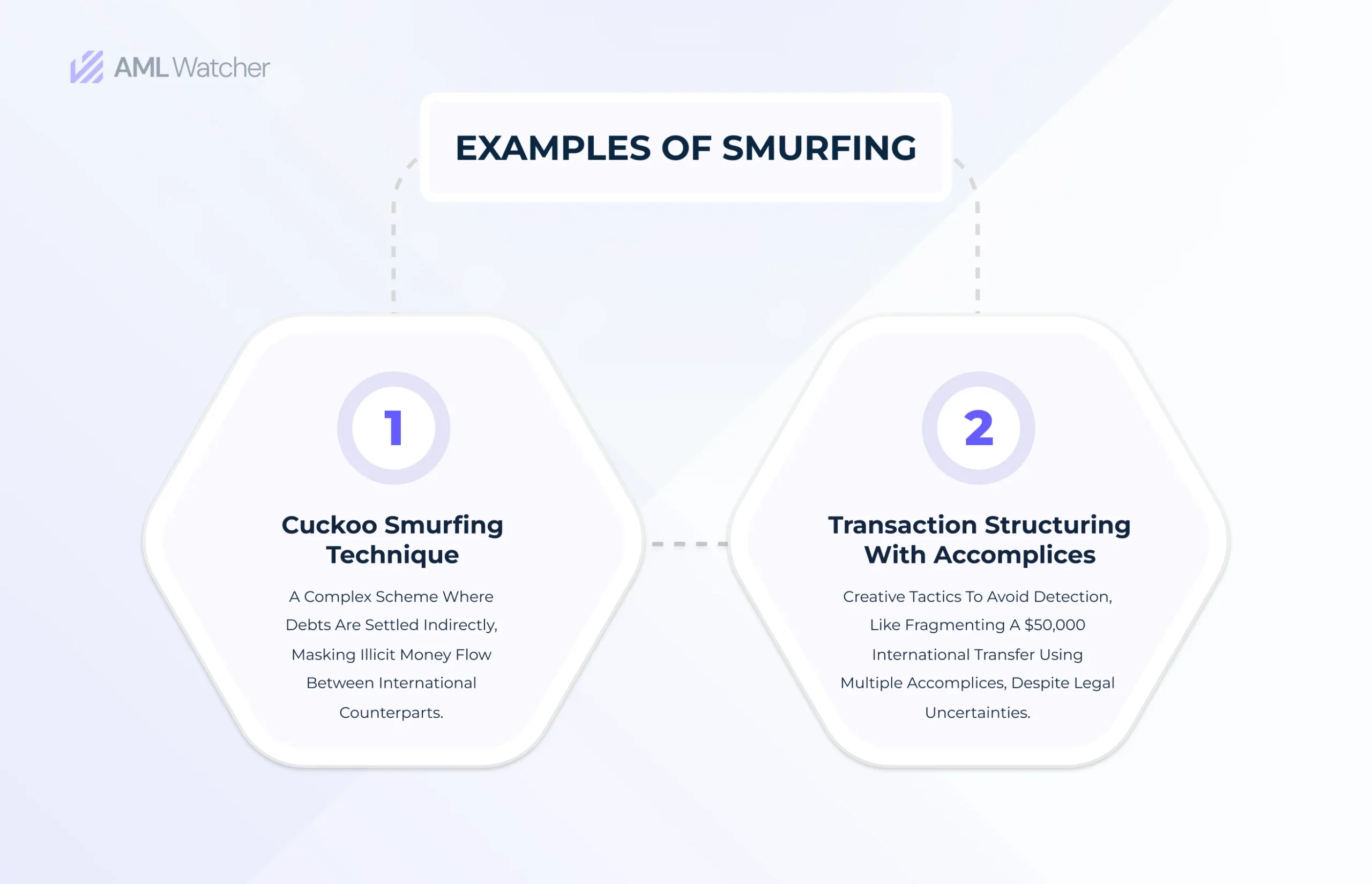
Evolution of Money Laundering: From Smurfs to Modern-Day Mules

History of Money Laundering
As per Financial Crime Academy, the origins of money laundering can be traced back over two millennia. Historian Sterling Seagrave notes that affluent Chinese merchants initiated the act of disguising their wealth to avoid regional trade restrictions. By devising methods like converting their riches into movable assets and transferring funds out of their jurisdiction, they shielded their assets from bureaucratic confiscations.
Fast-forward to the Prohibition era in the U.S., and just like AML compliance, money laundering took a new turn. Criminals, like the infamous Al Capone, laundered profits from illicit alcohol sales, filtering them through seemingly upright businesses. Though the phrase “money laundering” became popular during the Watergate scandal of the 1970s, its practice had already solidified its place in criminal operations.
Defining Money Laundering
In simple terms, money laundering involves obscuring the origins of funds acquired illicitly, making them appear as if they stem from legitimate sources. AML Laws across the globe define money laundering differently:
- In the U.S., it’s described as the act of engaging in financial transactions to hide the identity, source, or destination of illicitly acquired money.
- The U.K.’s common law definition paints a broader picture, labeling it as any action with assets (in any form) that are proceeds from crime, intending to mask the property’s origin or its beneficial ownership.
The Early Days: The Role of Smurfs
As an illicit financial technique, money laundering has evolved over time in many ways. One of the most intriguing and persistent strategies is “smurfing.” It’s possible that the word “smurfing” makes you think of blue, animated kids’ characters. The truth, however, is considerably more bleak. Smurfing is the practice of splitting substantial amounts of money gained illegally into smaller, less obvious transactions. These transactions are intended to avoid regulatory agencies’ and financial institutions’ suspicion and discovery by operating covertly.
Understanding the Smurfing Mechanism
Smurfing operates primarily in three distinct phases:
- Placement: The stage where ‘dirty’ funds are first introduced into the financial domain. A classic example involves a smurf discreetly transporting cash across borders in luggage for various ventures like foreign currency exchange or gambling.
- Layering: A phase characterized by obfuscating the money’s origin through complex financial maneuvers. Here, smurfs might transfer funds internationally, further diversifying into intricate overseas investments.
- Integration: The final act, where the now ‘cleaned’ money re-emerges into the financial mainstream, appearing as legitimate gains. Assets like luxury cars, properties, or artwork are often procured at this stage, making the illicit money trace harder.
Illustrative Examples of Smurfing
Cuckoo Smurfing Technique: Imagine a New York-based criminal owing $9,000 to a Paris counterpart. Concurrently, a Paris merchant owes an identical sum to a New York supplier. Through a series of orchestrated bank moves, both parties believe they’ve settled their debts, though the money never actually made a direct transfer.
Transaction Structuring with Accomplices: Circumventing detection involves creativity. An individual looking to transfer $50,000 internationally would trigger a Currency Transaction Report (CTR). To sidestep this, they may use multiple accomplices to fragment the transaction, a tactic that remains legally dubious.
Transition Towards Modern Money Laundering Techniques
Traditional methods like smurfing have been long taught in AML compliance training. While such methods still exist, modern criminals have upped the ante with the onset of digital transformation. One might assume that updated regulations, like the 4th AML Directive, would cover all facets of money laundering. However, a deeper look suggests that it might not adequately address the constantly evolving tactics.
Transaction Laundering
With the surge of cybercrimes, a more covert form of money laundering has emerged known as transaction laundering. In essence, it involves using legitimate merchant accounts to process concealed transactions for another website. These hidden transactions might involve illegal products or services or even high-risk endeavors that wouldn’t typically secure their merchant account. The scope is vast. In the US alone, transaction laundering contributed to $155 billion in online sales revenue in 2016. The growth of independent online shops has further fueled this trend.
Crypto Currency transactions:
Cryptocurrencies, operating on decentralized networks, offer transactional privacy by recording transactions on a blockchain. Furthermore, they keep parties’ identities hidden behind cryptographic addresses. Unlike traditional currencies controlled by central banks, cryptocurrencies function across a global, distributed computer network, challenging regulatory oversight. They enable cross-border transfers without intermediaries, facilitating illicit fund movements. Criminals further cloud transaction traces using tumblers or mixers that blend identifiable funds. Monero’s heightened privacy features and Ethereum’s anonymity capabilities are also leveraged for money laundering purposes.
Offshore Accounts:
Offshore jurisdictions often have strict banking secrecy laws, making it challenging for authorities to trace illicit funds. Money launderers exploit offshore accounts for layering, moving money across multiple accounts and jurisdictions to obscure its origin. They also use shell companies and trusts in lax-regulated areas to further distance funds from their illicit sources. The flexibility of some offshore banks, which may not require a physical presence to open accounts or provide swift online transfers, further facilitates money laundering. Additionally, these accounts support multiple currencies, enabling forex trades and various investment opportunities, such as real estate, to legitimize funds. To add a veneer of legitimacy, launderers sometimes even pay taxes on these illicit offshore funds.
Shell and Front Companies
A shell company, often devoid of significant assets or operations, serves primarily as a vehicle for various financial transactions, obscuring the true source and destination of funds. Front companies, on the other hand, have legitimate operations but are used to mingling clean and dirty money. By inflating revenues or engaging in fictitious transactions, these businesses can “launder” illicit funds, integrating them into the formal economy while obscuring their illicit origins.
Wrapping up:
The evolution of money laundering, from smurfs to modern-day mules, highlights the adaptability and resilience of financial criminals. As they devise new ways to conceal their ill-gotten gains, it underscores the importance of continuous innovation in regulatory frameworks and detection methods. AML Watcher can significantly mitigate these challenges. It deals with updated data and provides real-time monitoring. Furthermore, those cases which have already been convicted of smurfing through adverse media screening, wouldn’t be able to fool the system with AMT Watcher. Additionally, Its ability to integrate diverse data sources facilitates a cross-referenced, holistic analysis. This integration, combined with regular database updates, ensures the tool remains updated and equipped to pinpoint even the most sophisticated laundering techniques in a constantly changing landscape.
To stay ahead of the adaptive nature of money laundering, contact us.
We are here to consult you
Switch to AML Watcher today and reduce your current AML cost by 50% - no questions asked.
- Find right product and pricing for your business
- Get your current solution provider audit & minimise your changeover risk
- Gain expert insights with quick response time to your queries

 Compliance Guidelines: United Arab Emirates
Compliance Guidelines: United Arab Emirates
 Compliance Guidelines: Germany
Compliance Guidelines: Germany
 UK to Launch World’s First Sanctions Regime to Target Upstream People Smuggling
UK to Launch World’s First Sanctions Regime to Target Upstream People Smuggling
 Utah Lawsuit Alleges TikTok Livestreams Facilitated Money Laundering Activities
Utah Lawsuit Alleges TikTok Livestreams Facilitated Money Laundering Activities


 Why Should states conduct AML Due Diligence for CBI/RBI Investment Schemes?
Why Should states conduct AML Due Diligence for CBI/RBI Investment Schemes?
 How can businesses comply with US sanctions on vessels?
How can businesses comply with US sanctions on vessels?
 Difference In AML: DNFBPs Vs Financial Sector
Difference In AML: DNFBPs Vs Financial Sector
 Difference in EU and US Sanctions Programs - How It Impacts Compliance?
Difference in EU and US Sanctions Programs - How It Impacts Compliance?
 How Regulatory Gaps Fueling Money Laundering in High Risk Jurisdictions?
How Regulatory Gaps Fueling Money Laundering in High Risk Jurisdictions?
 Mapping Anti-Money Laundering Regulations in Malaysia
Mapping Anti-Money Laundering Regulations in Malaysia





